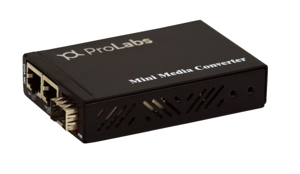 Today’s media converters are much more than a simple LAN extension device. Media converter technology has evolved to offer cost-effective solutions to network challenges.
Today’s media converters are much more than a simple LAN extension device. Media converter technology has evolved to offer cost-effective solutions to network challenges.
As the name implies, media converters allow for two different network media types to connect. Media converters are perhaps best known for connecting twisted-pair copper with fiber optics in a classic LAN environment. In this scenario, the media converter presents the various physical media interfaces (RJ-45 for copper and LC connectors for fiber) for connection to the network cabling. The media converter seamlessly connects the fiber and copper networks to one another.
 As mentioned at the onset of this post, today’s media converters offer much more to network operators than a simple device; they offer support for multiple media conversion applications:
As mentioned at the onset of this post, today’s media converters offer much more to network operators than a simple device; they offer support for multiple media conversion applications:
- Fiber to Copper / Copper to Fiber – This is the classic media converter application used most often to extend an Ethernet connection beyond the limitations of twisted pair copper.
- Fiber to Fiber – Media converters offer options to convert connections between single mode and multimode fiber, a duplex fiber pair and single fiber, or between two fiber pairs in a network transponder application.
- Copper to Copper – Media converters also offer solutions for connecting copper media. Should the network require extending a copper connection beyond 100 meters, a media converter is a valid option.
Media converters offer this vast functionality through the presentation of media interfaces. The first generation of media converters were not modular in design. Media converters had fixed features, for example, the copper interface was likely a 10BaseT, RJ45 connector while the fiber side may have been multi-mode fiber ST connector. The current generation of media converters provide the flexibility offered by a transceiver slot to mix and match transceiver options to the network requirement. The transceiver slots can be found on the fiber side or on both sides of the media converter. The transceiver ports may support 1G, 10/100/1000, and 10G data rates, as well as fiber connection distances of 80KM and longer!
Today’s media converters maintain the classic small footprint for ubiquitous deployments, including desktops, wire closets, and data centers. Most recently, media converters offer additional value-add features to meet a wide variety of network applications:
- Industrial temperature media converters are rated for the industrial temperature range (-40C to +85C) and can be DIN rail or wall mounted.
- Rackmount chassis – Many media converters can be stand-alone units or be installed into a rack-mount chassis for density and cable management.
- Managed – for higher value links, media converters offering management capabilities integrated into existing management systems.
- Power-over-Ethernet – POE media converters have POE injectors built into the unit to provide local power over video surveillance or phone applications.
Once the domain of LAN environments, media converters have found life as essential networking tools in an array of environments, providing the flexibility for administrators to choose the option that best fits each unique scenario. Look for a manufacturer that can provide a breadth of choices and offer expertise in choosing the best fit for each use case. To learn more about media converter options, view the ProLabs media converter brochure.
Content written by ProLabs Americas Product Manager, Ray Hagen


.png?width=58&height=58&name=X_logo_2023_(white).png)
